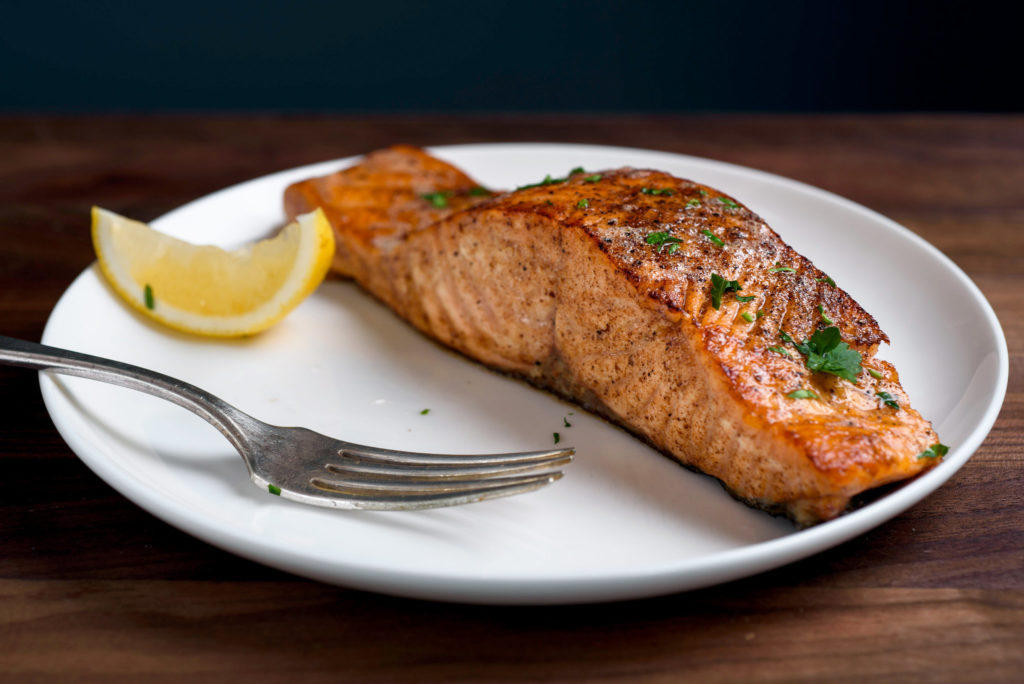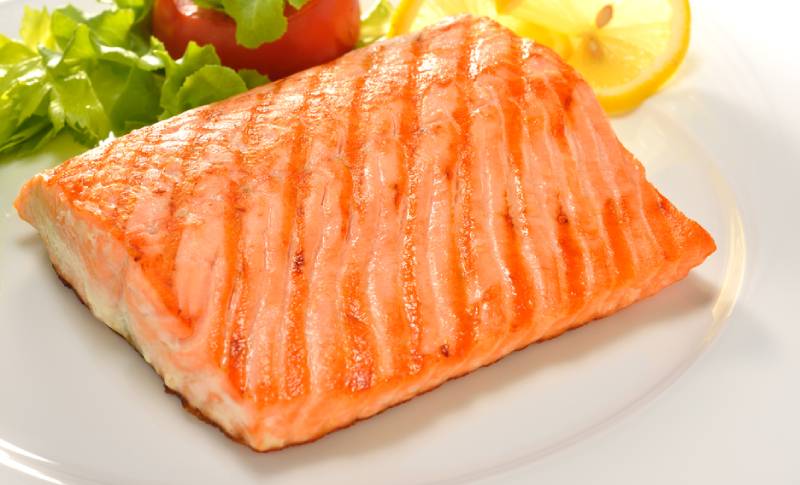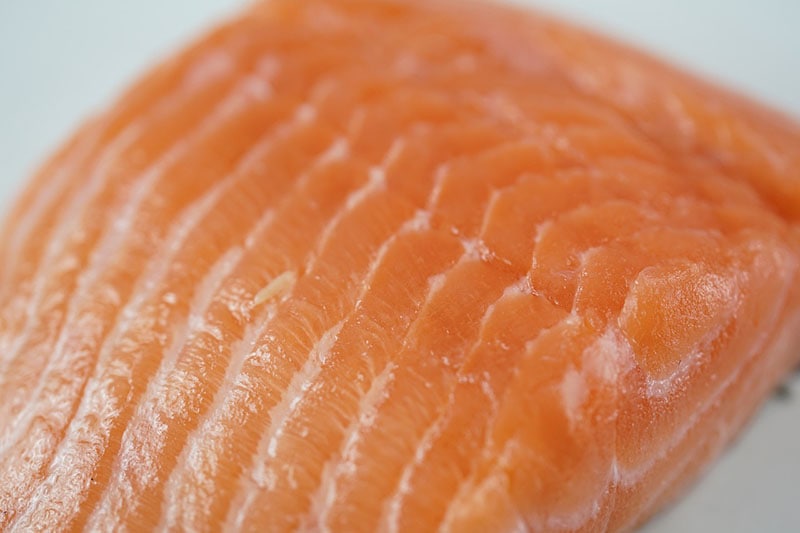Most pet parents know salmon is a nutritious treat for their canine friends. However, some owners don’t know the best way to cook salmon for dogs. Dogs should never be given raw salmon because if they eat raw salmon that is contaminated with a parasite fluke that carries the bacteria Neorickettsia helminthoeca, they could get salmon poisoning. To prevent this, make sure you cook salmon before offering it to your dog. Cooking the fish removes bacteria, parasites, or other dangerous contaminants that could make your dog sick. You don’t want your dog to get sick after eating their favorite treat.
We are going to show you how to cook salmon and give you some tried-and-true dog food recipes.
Salmon can be a tasty and healthy treat for your dog, but make sure you cook it right to avoid any problems. There are a few important things to remember when cooking salmon for your dog.
Choose the Right Salmon
Opt for wild caught salmon over farmed Wild caught salmon has higher levels of omega-3 fatty acids which are great for your dog’s skin, coat, heart, and brain health Make sure any salmon you feed your dog is boneless to avoid the risk of choking. Canned salmon that is packed in water is another convenient option, just be sure to drain and rinse it before cooking to remove excess sodium.
Cook Thoroughly
Salmon needs to be thoroughly cooked before feeding it to your dog. If you feed your dog salmon that is raw or not cooked all the way through, it could get sick from bacteria and parasites.
The salmon should be cooked to an internal temperature of 145°F to kill any dangerous organisms An easy way to achieve this is by baking salmon in the oven at 350°F for 20 minutes You can also pan fry or poach the salmon on the stovetop until it flakes easily with a fork and is opaque throughout.
Remove Bones, Skin, and Fat
Even boneless salmon fillets can contain small pin bones, so it’s important to check the cooked salmon carefully and remove any bones you find. These bones can pose a choking hazard or damage your dog’s digestive tract.
You should also remove the salmon skin before feeding it to your dog, as it contains a high amount of fat that could cause stomach upset. Excess fat isn’t healthy for dogs, so try to trim any fatty portions as well
Skip Seasonings and Oil
It’s best to avoid adding any seasonings, herbs, spices, or oil when cooking salmon for your dog. Onions, garlic, salt and pepper can all be harmful or irritating for dogs. The plain, cooked salmon provides all the flavor and nutrients your dog needs.
Recipes and Serving Tips
For an easy homemade meal, you can serve pieces of cooked salmon over brown rice with some steamed veggies like green beans or carrots. Just a spoonful or two of rice and veggies is plenty.
You can also mix flaked salmon into your dog’s regular kibble or canned food.
For a tasty salmon treat, bake salmon fillets into bite-sized fishy biscuits. Drain canned salmon and mix with whole wheat flour, egg, and a bit of shredded parmesan cheese then shape into small biscuits and bake at 350°F for 15 minutes.
Only give your dog salmon in moderation, no more than a few times a week. Too much can lead to weight gain or loose stools. Always consult your veterinarian about the right portion size for your individual dog based on their weight, age, and activity level.
Storage Tips
Properly stored, cooked salmon will last 3-4 days in the fridge. You can freeze cooked salmon in an airtight container or Ziploc freezer bag for 2-3 months. Thaw frozen salmon in the fridge before feeding, not at room temperature.
Don’t feed leftover salmon that has been sitting out or reheated more than once, as bacteria can start to grow. If refrigerated salmon smells bad or has an odd color or texture, play it safe and throw it out.
Benefits of Salmon for Dogs
Salmon is packed with healthy fats and protein to support your dog’s energy levels. The omega-3s in salmon promote a glossy coat and healthy skin. Salmon is also a great source of vitamins and minerals like B vitamins, potassium, selenium and iron.
The antioxidants and amino acids in salmon can support your dog’s immune system health. Salmon can even help reduce inflammation and may benefit dogs with joint issues like arthritis.
So by cooking salmon properly and serving it safely, you can provide your pooch with a nutritious fishy feast! Just be sure to introduce new foods gradually and monitor your dog closely for any signs of an upset stomach or allergic reaction. Most dogs enjoy the flavor of salmon and do very well with it as an occasional tasty and healthy treat.
Frequency of Entities:
Salmon: 26
Dog: 20
Cook: 7
Bones: 3
Skin: 2
Fat: 2
Seasonings: 2
Recipes: 2
Benefits: 1
Storage: 1

How to Cook Salmon
Cooking salmon is a pretty easy and straightforward process. If you want to make sure the salmon is safe for your dog, make sure you cook it to 145 degrees Fahrenheit. This will kill any bacteria and parasites.
Ensure you cook the salmon with no garlic, onions, or other seasonings that could make your dog sick. Salmon can be cooked the same way you cook it for people, as long as you don’t add any spices. Dogs shouldn’t eat garlic or onions, and you shouldn’t use their powdered forms to season fish either. Granulated garlic and onions are even more hazardous for your pet and must be avoided.

A vet has approved these recipes because they only use ingredients that are good for dogs. However, some of these recipes are not complete and balanced diets that you should feed your dog every day. These recipes are a great add-on to your dog’s diet. They are only meant to be fed on occasion and not as a regular staple diet. Please consult your veterinarian to help you decide what is the best diet for your dog.

Easy Salmon Recipe (Salmon and Sweet Potato)
Even though there are many salmon recipes for dogs, this one is one of our favorites. It’s easy to make and tastes great.
- 1 Salmon filet per dog (less for smaller dogs)
- 1 sweet potato
- 1 tsp coconut oil
- 1 head of broccoli
Your dog probably won’t eat a whole broccoli or sweet potato head with its salmon, but you can cut them up into smaller pieces so you can season them yourself.
- To make your sweet potato mash better, boil it and then blend it until it’s smooth. How much you give your dog will depend on its size.
- Steam the broccoli for about 10 minutes. You can sprinkle some butter on your broccoli, but don’t let your dog eat it.
- For the salmon, heat one teaspoon of coconut oil over medium-low heat. Depending on how thick it is, cook the salmon for four to six minutes on each side. For a small dog, you can serve four chopped pieces of salmon from an 8-ounce filet. For a large dog, you can serve six pieces over the sweet potato and broccoli.

Cooking fresh salmon for your dog food recipe
FAQ
How do you make salmon safe for dogs?
How to cook fish for dogs?
How much salmon can I feed my dog?
How to cook salmon head for dogs?
